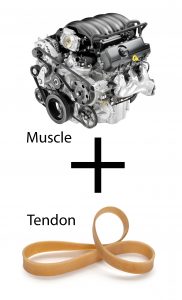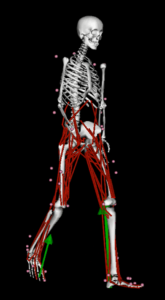1. “Muscle fibre length and velocity in running and walking”: How muscle fiber lengths and velocities affect muscle force generation as humans walk and run at different speeds (Arnold et al. 2013)
Why I like it: Uses advanced musculoskeletal modelling techniques to quantitatively explore the effects of the fundamental phenomenological properties of muscle fibres on the mechanical demands of gait; advances our knowledge and understanding of the basic drivers of muscular coordination in human gait; helps us understand the physiological motives for the walk-transition.
Take home message: Muscle fibre lengths and shortening velocities in the ankle plantarflexors are important in determining the walk-run transition; force generation capability of the ankle plantarflexors decreases with increasing walking speed because of increasing shortening velocity and larger changes in fibre lengths. But this is restored with the transition to running. Suggests the walk-run transition is a kind of physiological switch to ensure maximum effectiveness of the ankle plantarflexors. Greater compliance in a muscle-tendon unit reduces the impact of musculoskeletal geometry (joint angles, joint velocities, muscle moment arms) on the ability of those muscles to generate angular power about the spanning joint, and enabling muscle activation and tendon stretch to determine mechanical output.
2. “Achilles tendon behaviour in running”: Tendon elastic strain energy in the human ankle plantar-flexors and its role with increased running speed (Lai et al. 2014)
Why I like it: Extends the modelling work of Arnold et al. 2013 with focus on the interaction between ankle plantarflexor tendon and muscle fibres on the mechanical demands of running gait; utilises advanced musculoskeletal modelling techniques; focus on metabolic cost provides a different insight into the evolution of the ankle plantarflexors as a principal muscle in running gait.
Take home message: A compliant tendon allows the entire ankle plantarflexor muscle-tendon unit to undergo large length and velocity changes while enabling the muscle fibres themselves to remain relatively isometric; compliant tendon stores and returns large passive strain energy improving overall muscle-tendon unit efficiency, but additionally stores and returns large active strain energy from isometric muscle fibre contraction. This substantially increases the overall stretch-recoil capabilities of the Achilles tendon.
3. “Tendon compliance and metabolic cost”: Stretching Your Energetic Budget: How Tendon Compliance Affects the Metabolic Cost of Running (Uchida et al. 2016)
Wh y I like it: Continues to explore the effect of ankle plantarflexor muscle-tendon properties on the mechanical demands of running using advanced musculoskeletal modelling techniques; helps advance our understanding of the evolutionary “tuning” of the key muscles in human gait.
y I like it: Continues to explore the effect of ankle plantarflexor muscle-tendon properties on the mechanical demands of running using advanced musculoskeletal modelling techniques; helps advance our understanding of the evolutionary “tuning” of the key muscles in human gait.
Take home message: Compliant tendons do not imply reduced metabolic cost; at each tested speed of running, tendon strain at 2-3% provides the lowest metabolic cost; increasing or decreasing compliance beyond this range increases metabolic cost; soleus and gastrocnemius show different behaviours, with the soleus demonstrating greater economy at higher tendon compliance, while the gastrocnemius demonstrates greater economy at lower tendon compliance. In each case, the specific tendon compliance which provided greatest economy enabled the muscle fibres to remain relatively isometric throughout the gait cycle. Modelling metabolic cost may provide better insights into the fundamental drivers of neuromuscular coordination than simply analysing muscle activations or mechanical power.



